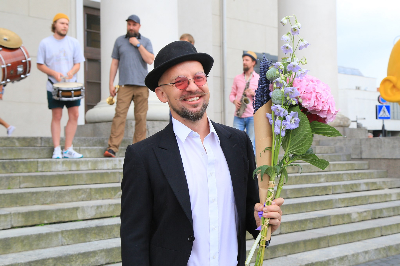
©
У Варшаві литовський скульптор Мартінас Гаубас представив сатиричну скульптуру під назвою «Чуйло», що символічно зображує президента РФ Володимира Путіна у вигляді чоловічого статевого органа в касці. Інсталяцію встановили перед радянським меморіалом — місцем, де щороку російські дипломати намагаються покласти квіти до річниці перемоги над нацизмом, попри суспільний спротив. За словами митця, ескіз скульптури був створений ще у 2022 році, коли він сподівався на швидке завершення війни. Проте, зрозумівши, що агресія триває вже три роки, Гаубас вирішив завершити проєкт саме до цієї дати — як художнє нагадування про три роки спротиву. Автор пояснив, що скульптура має глибоку символіку: маленькі очі та вуха уособлюють байдужість Путіна до реальності, довгий ніс — його брехливість, а каска — ізоляцію в бункері. За словами скульптора, це не просто артоб’єкт, а вираз політичної позиції, звернений як до європейців, так і до самих росіян. «Важливо, щоб литовці не мовчали, а росіяни знали: у Європі їм не раді», — зазначив Гаубас. Скульптура вже викликала значний резонанс у Литві та за її межами, ставши яскравим прикладом мистецького протесту проти російської агресії.
Provocative Sculpture of Putin Unveiled in Warsaw as a Protest Against the War in Ukraine
In Warsaw, Lithuanian sculptor Martynas Gaubas unveiled a provocative artwork titled “Chuilo”, which symbolically depicts Russian President Vladimir Putin as a phallic figure wearing a helmet. The installation was placed in front of a Soviet memorial — a site where, each year, Russian diplomats attempt to lay flowers commemorating the victory over Nazism, despite growing public opposition. According to the artist, the sketch for the sculpture was created back in 2022, when he still hoped the war would end quickly. However, as the conflict dragged on into its third year, Gaubas decided to complete the work as a stark reminder of ongoing aggression. The sculpture carries symbolic elements: small eyes and ears represent Putin's detachment from reality, a long nose alludes to his deceitfulness, and the helmet signifies his isolation in a bunker. Gaubas emphasized that this is not a decorative piece but a bold political statement aimed at both Europeans and Russians. “It’s important that Lithuanians don’t stay silent — and that Russians know they’re not welcome in Europe,” the artist said. The sculpture has already stirred significant public reaction in Lithuania and beyond, becoming a powerful example of artistic protest against Russian aggression.
1175